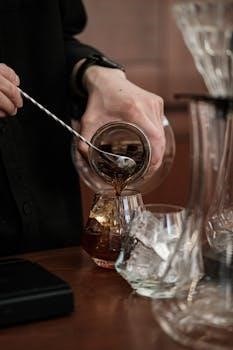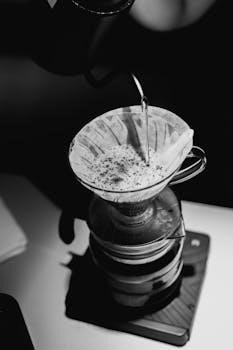What is Pour Over Coffee?
Pour over coffee is a manual brewing method where hot water is poured over coffee grounds in a filter, allowing the brewed coffee to drip into a carafe or mug. It contrasts with automatic drip machines, offering the barista complete control over the brewing process, thus making it a technique known for bringing out vibrant flavors and showcasing coffee complexity.
Pour Over vs Drip Coffee
The fundamental difference between pour over and drip coffee lies in the brewing process. Both methods involve hot water seeping through coffee grounds to extract the brew. However, pour over is a manual method, where a barista pours hot water over coffee grounds, offering complete control over variables such as water temperature, pouring speed, and bloom time. This hands-on approach allows for a more nuanced and personalized brewing experience. Drip coffee, conversely, typically uses an automated machine that controls most of the brewing variables. While drip machines offer convenience and consistency, they lack the flexibility and control offered by the pour over method, which allows for exploration of diverse flavor profiles. Pour over often showcases the coffee’s complexity more effectively, while drip coffee aims for reliable, everyday convenience. The manual nature of pour over also enables a more intimate connection with the brewing process, making it a ritualistic experience for coffee enthusiasts. Ultimately, the choice between pour over and drip depends on the desired level of control, convenience, and the pursuit of coffee flavor nuances.
The Essence of Manual Brewing
Manual brewing, especially with pour over, embodies a hands-on approach to coffee preparation, emphasizing the barista’s control over all variables. Unlike automatic methods, this process allows for a deeper connection with the coffee itself, transforming brewing into an art form. The essence of manual brewing lies in the ability to adjust elements such as grind size, water temperature, pouring technique, and brewing time to precisely tailor the extraction to your liking. This control opens the door to exploring a wide spectrum of flavor profiles, bringing out subtle nuances that may be lost in automated processes. The manual method also introduces the opportunity for human error, which, while a risk, also makes for a more engaging and rewarding process when perfected. It is a ritualistic practice that requires focus and attention, turning a simple cup of coffee into a mindful experience. The essence of manual brewing is therefore not just about making coffee, but about the journey of learning, experimenting, and ultimately mastering the craft to achieve the desired brew.

Choosing the Right Coffee
The best coffee for pour over is subjective, but light or medium roast single-origin coffees are often favored for their clarity and complexity. However, there is no reason not to experiment with dark roasts or blends to find what best suits your taste.
Best Coffee Types for Pour Over
When selecting coffee for pour over, consider that this method excels at highlighting nuanced flavors. Single-origin coffees, particularly light to medium roasts, are often preferred due to their inherent complexities. These roasts tend to showcase the coffee’s origin characteristics, offering a more vibrant and tea-like experience. However, this doesn’t mean you’re limited; experimenting with various roasts and blends is key to finding your ideal cup. Darker roasts, while not as common, can still produce a satisfying brew if that’s your preference. The important aspect is to choose coffee that you enjoy, allowing the pour over method to bring out its best qualities. Ultimately, the best coffee for pour over is the one that matches your personal taste preferences, so feel free to explore and discover what you love the most.
Experimenting with Roasts
The world of coffee roasts offers a broad spectrum of flavors and characteristics, and experimenting with them in your pour over is a journey worth taking. Light roasts often bring out the brighter, more acidic notes of a coffee, while medium roasts tend to be more balanced, offering a harmony of flavors. Darker roasts, on the other hand, can provide richer, bolder profiles, sometimes with smoky or chocolatey undertones. The key is to understand how the roast level interacts with the pour over method to achieve your ideal cup. Exploring different roasts will expand your palate and help you understand your preferences better, whether you like the delicate nuances of a light roast or the robust character of a dark roast. Don’t be afraid to step out of your comfort zone and try new things.

Equipment Essentials
Essential equipment for pour over includes a brewer, a gooseneck kettle for controlled pouring, and filters. Each element plays a vital role in the brewing process, impacting the final flavor and clarity of the coffee.
Pour Over Brewers
Pour over brewers come in various shapes and materials, each influencing the brew’s characteristics. The Hario V60, known for its conical shape, is a popular choice, often requiring a gooseneck kettle for precision. The Kalita Wave, with its flat bottom and three holes, promotes even extraction. Other options include the Chemex, which offers a cleaner brew due to its thick paper filters, and single-hole pour over cones, which are simpler and effective. These brewers, unlike immersion methods like a French press, continuously saturate coffee grounds for a faster, more efficient brew. Manual brewers are commonplace and allow for mastery and human error. The choice depends on personal preference, desired flavor profile, and the experience level of the user. Some brewers like the Hario Switch offer unique features, like the ability to control contact time, while others like the Espro Bloom provide fast and easy brewing.
Gooseneck Kettle Importance
A gooseneck kettle is a crucial tool for pour over coffee brewing due to its unique spout design, which allows for precise control over the water flow. This control is essential for achieving an even saturation of the coffee grounds, preventing channeling, and ensuring optimal extraction. The narrow spout and the angle of the gooseneck allow you to target specific areas of the coffee bed, which is particularly important with brewers like the V60. While not strictly necessary for all types of pour over devices, a gooseneck kettle significantly enhances the consistency of the brew. It’s a great help with the Chemex, and vital for a V60, as it promotes a more harmonious and even extraction. It helps to regulate the pouring speed and avoid over extraction or bitter flavors. Without the precision of a gooseneck, it’s much harder to achieve a well-balanced, flavorful pour over coffee.
Filters for Pour Over
Filters are a fundamental component of pour over coffee brewing, serving to separate the brewed coffee from the grounds, resulting in a cleaner, sediment-free cup. The type of filter used can impact the final flavor profile of your brew. Paper filters, the most common type, come in various shapes and thicknesses, each affecting the flow rate and extraction. Some are bleached, and some are unbleached. Metal filters, a reusable alternative, allow more oils and fines to pass through, resulting in a fuller-bodied cup. Cloth filters offer a balance, providing a smooth cup with slightly more body than paper. Pre-wetting the filter before brewing is a crucial step, as it removes any paper taste and also helps to warm the brewing device. Choosing the right filter for your preferred taste is a key step in optimizing your pour over experience, and they come in a variety of shapes and sizes to fit specific brewers.

Brewing Process
The brewing process of pour over coffee involves several key steps, from preparing the filter and grinding the beans to carefully pouring hot water over the grounds and observing the extraction. Each step impacts the final cup, allowing for a personalized brewing experience.
Step-by-Step Pour Over Instructions
To begin, place your filter into the pour over brewer, and pre-wet it with hot water to eliminate any papery taste and warm up the brewer. Next, grind your coffee beans to a medium-fine consistency, similar to sea salt, and measure out the appropriate amount, usually around 1 gram of coffee per 16ml of water. Place the ground coffee into the filter, creating a small well in the center. Start the brewing process by pouring a small amount of hot water, around 200-212°F (90-100°C) for light roasts, and lower temperatures for darker roasts, over the grounds in a circular motion. This step, known as the bloom, allows the coffee to degas for about 30 seconds. Continue pouring the remaining water in slow, controlled circles, avoiding the edges of the filter. Aim for a total brew time of around 2-4 minutes. Once complete, remove the brewer and enjoy your freshly brewed coffee.
Grind Size and Its Impact
The grind size of your coffee is a crucial factor in achieving the perfect pour over brew. For pour over, a medium-fine grind, resembling sea salt or table salt, is typically recommended. This consistency allows for proper extraction, where water flows through the coffee bed at an ideal pace, pulling out the desired flavors and aromas. A grind that is too coarse will result in under-extraction, leading to a weak and sour cup. Conversely, a grind that is too fine will cause over-extraction, making the coffee taste bitter and harsh. Adjusting your grind size is essential to achieve balanced extraction. Experimenting with different grind sizes based on your coffee and equipment is key to mastering the pour over method. Remember, small adjustments in grind size can significantly impact the overall flavor profile.

Water Temperature Guidelines
Water temperature plays a critical role in the pour over brewing process, directly impacting the extraction of coffee compounds. Generally, water between 195-212°F (90-100°C) is suitable for light-roasted coffees, while medium roasts benefit from 185-200°F (85-93°C), and dark roasts do best with 175-190°F (79-88°C). Using water that is too hot can lead to over-extraction, resulting in a bitter taste. Conversely, water that is too cool can cause under-extraction, producing a weak and sour brew. If you don’t have a temperature-controlled kettle, bring water to a boil and let it sit for a minute or two before using. Precise temperature control, whether through a specialized kettle or a thermometer, is essential for consistently great results, as it allows for optimal flavor extraction. This attention to detail is a hallmark of the pour over method.
Pouring Technique and Bloom
The pouring technique in pour over coffee is crucial for even extraction. A slow, steady pour, avoiding the edges of the filter, ensures that water passes through the grounds uniformly. The initial pour, known as the ‘bloom,’ is particularly important. This involves saturating the coffee grounds with a small amount of hot water and allowing them to sit for about 30 seconds. This process releases trapped gases, allowing for a more balanced extraction. A gentle, circular motion is ideal for the bloom, followed by a more controlled pour for the remaining water, maintaining a consistent water level. This method prevents channeling and ensures all grounds are equally saturated, which results in a more delicious and well-rounded cup of coffee. Mastering the bloom and the pouring technique is essential for consistently great pour over results.
Brewing Time and Extraction
Brewing time and extraction are key factors in achieving a balanced pour over coffee. The ideal brewing time typically ranges from 2 to 4 minutes, though this can vary based on grind size and desired strength. Extraction refers to the process of dissolving soluble compounds from the coffee grounds into the water. Under-extraction, characterized by a sour taste, occurs when brewing is too short. Over-extraction, resulting in a bitter taste, happens when brewing takes too long. Aiming for a balanced extraction ensures that the coffee’s inherent flavors are highlighted. Monitoring the total brew time is crucial, and adjusting the grind size and pouring technique can help fine-tune the extraction. Consistency in these elements leads to repeatable results and a perfectly brewed cup every time. The goal is to extract the optimal amount of flavor compounds without overdoing it.